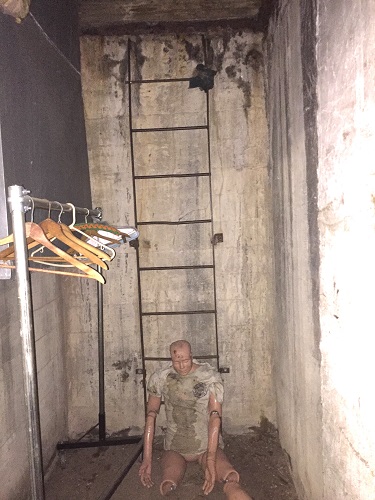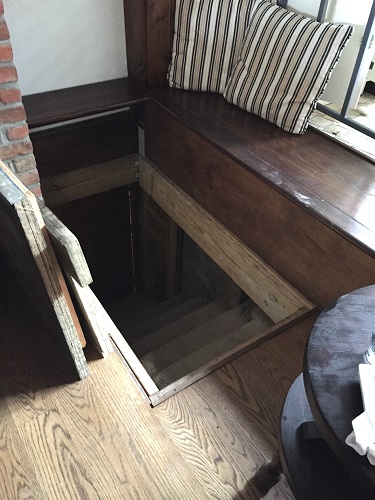By Adam J. Hansen and Jason Hoevelmann
In part 1 of this article series, we discussed how basements, cellars, and all belowgrade areas exacerbate the dangers within the ultra-hazardous environments in which we operate.
The perils that exist underground are infinite. After identifying the location of a belowgrade fire, the dynamics of our strategies and tactics change instantly. Adding to the hazards that are always present is the high probability of limited access. Unlike the living spaces of dwellings, which may have multiple windows, doors, and so on, it is extremely common for belowgrade areas to have limited or even no access points. If your crew can’t make swift entry and put water on the seat of the fire, then your inherently dangerous belowgrade fire can rapidly progress and change the entire dynamic and safety of the incident. As stated in our previous article, the intention of this series is to highlight a few not-so-common hazards regarding the ingress and egress of belowgrade environments.
Authors’ Note: Depending on your response district, these hazards may be normal in your daily operations.
Hatchway Door with No Staircase
Structures with belowgrade compartments often have interior stairs leading to the basement. In addition, a secondary means of access may be located on the exterior of the structure. Depending on the lay of the land, exterior access may consist of your basic hinged door with a key in the knob lock, full-sized windows, or a garage door. Foundations built on relatively even terrain are far more common than foundations built on sloped grades. Whether sizing up a multistory apartment building or a single-family wood house, an extremely common access point is the metal hatchway/basement bulkhead door.
(1) The exterior view of a typical metal hatchway/basement bulkhead. (Photos by authors.)
You will find metal hatchways/basement bulkheads, also known as “Bilco Doors,” in every response district across the county (photo 1). Contractors choose to install metal hatchway doors for several reasons: (1) To facilitate the tenant/homeowner with direct and clear access for moving large furniture/bulky appliances, (2) to provide for an external, belowgrade emergency exit, (3) to access mechanical equipment during construction, and (4) to provide convenient access as would be in all rooms of the house.
With widths ranging from 45 to 55 inches and lengths of 43 to 74 inches, metal hatchways/basement bulkheads make for an extremely convenient way to access bulky storage without the need for using narrow interior staircases. This allows for avoiding the gouging of finished sheetrock and destroying the interior of the structure.
Metal hatchways/basement bulkheads are generally all constructed and secured with the same techniques. They are customarily built by securing two sides of the assembly to a level concrete perimeter base and the header to the structure. The two sides of the hatchway are identical and generally triangular in shape to create a sloped pitch to the bulkhead. On top of these triangular sides rests two metal doors/panels that overlap. The locking mechanism typically consists of a single slide bolt lock with internal mounting flanges, making for a safe and secure door.
To make life easier for contractors/homeowners, these doors commonly arrive preassembled and are simply set/secured into place. For detailed information pertaining to the forcible entry of metal hatchway doors, please read “Forcible Entry of Hatchway Doors” by Howard Blythe and Frank Ricci.
On opening a metal hatchway/basement bulkhead, you can generally expect to find a six- to 10-step staircase descending belowgrade. Depending on how deep the compartment, one could anticipate fewer steps in a single-family dwelling and more steps in a larger commercial building. The steps descending from metal hatchway/basement bulkheads tend to be made predominantly of one of two basic materials: concrete or wood. One of the most common types of stairs installed in today’s basements is precast concrete basement stairs (photo 2). These precast stairs arrive at the construction site in one piece and are simply set into position using hydraulic machinery and are secured into place. Simple to install, fortified, long-lasting, and relatively cost effective, many construction crews consider this the standard when installing an exterior belowgrade stair. Contractors/homeowners may prefer to install a wooden staircase as opposed to precast concrete. These stairs may be built by using traditional stick lumbar or come in kits which tend to be relatively easy to assemble. Whether dealing with concrete or wood, both can achieve the desired end-result if constructed properly.

(2) A precast concrete exterior staircase that has been delivered and installed into place.
Scenario: Your engine company is the second-due apparatus dispatched to a reported structure fire at a large one-story commercial building. The first-arriving engine reports “Heavy smoke pushing from the eves with no visible fire from the exterior.” Thinking the fire is on the main floor, the first engine company stretches a line through the Alpha Side/main entrance of the structure.
You arrive on the scene when a worker runs up and says, “The fire’s in the basement.” After relaying this critical information to the interior crew and other companies arriving on scene, you ask the worker, “What’s the best access point to get down to the basement?” He points to the Charlie side/rear of the building. You reposition your apparatus on the Charlie side and begin looking for an access point. However, what you discover is a metal hatchway door. One member of your company starts flaking out an attack line and calling for water while another gets to work on the hatchway door, which is locked.
A rotary saw makes short work of the slide bolt, and the hatchway door is quickly forced open. With the charged/bled line in hand, you open the two overlapping metal doors to find thick black smoke pushing up the bulkhead. The opening to the hatchway is “lights out.” Your crew masks up and gets ready to begin their decent to locate the fire.
The nozzleman takes one step over the threshold of the metal hatchway and rapidly falls into the smoke; he is nowhere to be found. Caught up in the excitement, he missed the simple but critical step of sounding the stairs, not realizing there weren’t any. His initial anticipated first step onto a concrete stair instead turned out to be a 10-foot fall into the basement.
In most situations, some sort of staircase—as described before—will be found after you open the metal hatchway/bulkhead. On occasion, contractors may decide not to install stairs or, in other settings, the staircase may be removed by the building owner to promote a specific activity to be performed within the belowgrade compartment. The decision to not have a staircase may be necessary to facilitate the moving of (1) large volumes of product, (2) products which are heavy, or (3) any other need which is specific to the operation of a business. The reasoning behind removing the staircase could be to place a conveyer belt-type system, an elevator/lift, a conduit, or any other means of transporting material from upper to lower levels and vice versa.
In other settings, you may find a vertical steel ladder bolted to the interior concrete wall (photos 3, 4). To allow for large objects to move vertically and uninterrupted, a ladder flush with the wall may be installed. This feature will be found primarily in commercial-type occupancies. However, some older or repurposed residential structures could possess this feature. Essentially, a steel “fire escape ladder” bolted into the wall allows for an extremely streamlined access point penetrating only a few inches out from the wall. This design maximizes the space of the opening and makes an uninterrupted path for hauling products.
Not sounding the stairs prior to entering a hatchway/bulkhead with a vertical ladder creates a fall risk for a firefighter descending into an immediately dangerous to life or health environment (IDLH). Even if the basement were tenable, an unexpected fall onto the basement floor could lead to serious injury or death.

(3) A frontal view of a vertical steel ladder bolted to a concrete wall.
The ingress of a metal hatchway/bulkhead with “fire escape”-type ladders highlights only one of the hazards of belowgrade access. A second hazard presents itself with the operation of the egress. One can become disoriented in a belowgrade compartment with zero visibility. Depending on the situation, there is a high probability that a firefighter would be following a wall looking for an egress point.
RELATED: Wedding on VES: First-Floor Window Access ‖ Martin on Roof Access ‖ Lewis on Access to Gated Communities
As stated in Part One of this series, a firefighter would feel for a staircase, window, or door as he proceeds down a wall. With the thin steel ladder—set vertically and only a few inches off the wall—there is a high probability that the egress point will be passed by and missed. Operating in an IDLH atmosphere, lost, and with a finite amount of air in his self-contained breathing apparatus (SCBA), a firefighter needs to move quickly to remedy the situation or he will miss the point of egress.
(4) An overview of a vertical steel ladder.
Basements with Concealed Access Points
When operating on the interior at a structure fire, the many unknowns only add to the already demanding tasks we face. Hoarded rooms, hidden apartments, and sheet rock over plywood ceilings are just a few examples of the immense challenges we face. One challenge that is extremely common in our daily operations is locating the interior staircase that leads belowgrade. The simple act of finding the interior basement staircase during investigation calls and with 100-percent visibility can be extremely challenging. Knowing the basic blueprint of the structures that comprise our districts is paramount.
That being said, there’s no guarantee you will know the exact location of interior belowgrade access. We’ve all been to “odor of smoke in the basement” calls where you and your crew had to open several doors leading to closets and bathrooms before finally locating the access point to the basement. The potential difficulties involved in finding the basement door is made far worse if the access point is concealed.
Scenario: You are dispatched for a report of heavy smoke in an area of a commercial block in your city. It’s a rainy/cold night, and you arrive to find a one story, multiunit storefront (strip mall) with heavy smoke coming from all corners of the building. Unsure of the fire’s location, you begin your 360° walk-around. There is no visible fire showing from the exterior, but you can “read” the smoke. You have a strong feeling that the fire is in the basement of the restaurant of the strip mall. On completion of your 360°, you determine there is no exterior access to the basement, and you will have to locate an interior staircase.
After forcing the aluminum-frame commercial door, ensuring to keep the glass intact, you proceed through the main doorway with a charged handline. Crossing the threshold of the doorway, you scan the room with your thermal imaging camera to identify heat signatures throughout the floor boards. Your knees start to feel warm. Your crew attempts to locate an access door to the basement. The occupancy has an open-style floor plan you advance and search all perimeter walls but are unable to locate access to the basement.
Several minutes go by when incident command calls for all interior companies to evacuate the building. After vacating the structure, taking off your mask, and feeling defeated for not being able to find the basement, heavy fire suddenly takes over the entire first floor. The once-contained basement fire is now burning to the ground before your very eyes. Without having performed a previous walk-through of this building, even the best, most experienced firefighter would not have been able to locate the single three- × five-foot wooden hatchway hidden beneath a throw rug and dining table (photos 5, 6).

(5) A wooden, belowgrade hatchway door concealed with a dining table and chairs.
From our experience, belowgrade compartments with concealed access tend to be found in older buildings, often a result of obsolete construction designs or because of the makeup of the surrounding land. Between fire codes evolving and contractors building to a higher standard, entry points in newer construction tend to be more visible and accessible. Installing full-size doorways and implementing improved industry standards seem ever more common when we are out familiarizing ourselves with new construction in our districts. There are various orientations in which concealed access points can present themselves such as hatchways built flush with the floor, removable wall panels camouflaged within the wall, wall panels located deep in a closet, and scuttles which have been covered over with stock.
In reviewing the last scenario, if there were a hatchway located within the restaurants seating area, why would a business owner want to keep the access area exposed? In case of a fire? Maximizing space equates to maximizing profits; this is a fundamental principle for all business owners. Additionally, for the purpose of aesthetics, businesses want to obscure unsightly things, such as hatchways, from their patrons to improve business. These are realities that make belowgrade access even more challenging and dangerous.

(6) A wooden hatchway removed with a small staircase leading to the belowgrade compartment.
What complicates concealed access even more is when the belowgrade compartment isn’t used simply for storage but also houses important utilities such as gas and electrical meters. What may happen is that concealed entry points become the only way of accessing a building’s utilities. Assigning utility control may not be the most exciting job on the fireground, but it is extremely important for the safety and effectiveness of the operation. Gaining access to utilities is not simply a concern in the fire unit itself; it could be far-reaching and affect the operations of every unit in a multioccupancy building.
A fire confined to a unit in a strip mall on the Delta side could have electrical and gas shutoffs located in a basement three units down on the bravo side. Recognizing that the utilities are not located in the fire unit is a challenge in and of itself, but the demanding task of locating the concealed access point leading to the utility shutoffs three units over is even more daunting.
(7) Several gas meters located in a basement with concealed access. The only way to access the individual gas shutoffs for each storefront is through one single concealed access point.
(8) Again, here are several electric meters and panels serving several units all located in one basement with concealed access.
Concealed access points leading to belowgrade compartments create unsuspecting hazards, can easily ruin the entire operation, and turn a small fire into a complete loss. One way to avoid this nightmare is to get out and identify these buildings and access points prior to the alarm coming in.
 Adam J. Hansen is a lieutenant with the City of Milford (CT) Fire Department assigned to Engine Company #7. He began his career as a volunteer in his hometown of Branford (CT) in 1999 and was hired with Milford in 2006. Hansen is a graduate of the University of New Haven where he earned a bachelor’s of Science in fire science, (fire administration) and a minor in criminal justice. He is a nationally registered paramedic and is a state certified fire instructor 1, fire officer 1, incident safety officer, pump ops, aerial ops, and technical rescue: Trench.
Adam J. Hansen is a lieutenant with the City of Milford (CT) Fire Department assigned to Engine Company #7. He began his career as a volunteer in his hometown of Branford (CT) in 1999 and was hired with Milford in 2006. Hansen is a graduate of the University of New Haven where he earned a bachelor’s of Science in fire science, (fire administration) and a minor in criminal justice. He is a nationally registered paramedic and is a state certified fire instructor 1, fire officer 1, incident safety officer, pump ops, aerial ops, and technical rescue: Trench.
 Jason Hoevelmann is a career battalion chief with the Florissant Valley Fire Protection District in North St. Louis County, Missouri, and is a volunteer deputy chief/fire marshal for the Sullivan Fire Protection District, where he started as a junior firefighter 32 years ago. Hoevelmann has served as second vice president for the International Society of Fire Service Instructors, a board of director for the IAFC’s Fire Life Safety Section, and contributes to local and regional organizations. He presents in the United States and Canada on leadership, officer development, strategy and tactics, and incident command. Hoevelmann is also a regular contributor Fire Engineering and is co-owner of Engine House Training, LLC.
Jason Hoevelmann is a career battalion chief with the Florissant Valley Fire Protection District in North St. Louis County, Missouri, and is a volunteer deputy chief/fire marshal for the Sullivan Fire Protection District, where he started as a junior firefighter 32 years ago. Hoevelmann has served as second vice president for the International Society of Fire Service Instructors, a board of director for the IAFC’s Fire Life Safety Section, and contributes to local and regional organizations. He presents in the United States and Canada on leadership, officer development, strategy and tactics, and incident command. Hoevelmann is also a regular contributor Fire Engineering and is co-owner of Engine House Training, LLC.

